kafka集群环境部署fabric1.4.6
Posted 尘缘何人续xh
tags:
篇首语:本文由小常识网(cha138.com)小编为大家整理,主要介绍了kafka集群环境部署fabric1.4.6相关的知识,希望对你有一定的参考价值。
kafka集群模式下部署fabric
先把 crypto-config.yaml 和 configtx.yaml 两个文件上传到kafka0这个服务器。
找到我们部署单机环境的那个包hyperledger-fabric-linux-amd64-1.4.6.tar.gz
首先,我们在kafka0或者说默认为第一台服务器进行操作。
cd /opt/gopath/src/github.com/hyperledger/fabric/kafkapeer
然后将压缩文件上传到这个目录下,解压,赋权。
(按理来说这里在singlepeer目录下就是这个包,所以可以直接复制过来)
cd /opt/gopath/src/github.com/hyperledger/fabric/singlepeer
cp hyperledger-fabric-linux-amd64-1.4.6.tar.gz /opt/gopath/src/github.com/hyperledger/fabric/kafkapeer/
tar -zxvf hyperledger-fabric-linux-amd64-1.4.6.tar.gz
chmod -R 777 ./bin
然后我们再生成公私钥和证书。
./bin/cryptogen generate --config=./crypto-config.yaml
然后生成创世区块的文件
mkdir channel-artifacts
./bin/configtxgen -profile TwoOrgsOrdererGenesis -outputBlock ./channel-artifacts/genesis.block
然后生成通道配置文件:
./bin/configtxgen -profile TwoOrgsChannel -outputCreateChannelTx ./channel-artifacts/mychannel.tx -channelID mychannel
那么现在这个目录下应该有这些东西:

接下来就需要用到我们上一篇文章配置的服务器免密登录了。我们生成的证书文件,为了保证集群的一致性,这里要求8台服务器是用第一台的证书文件的。
cd ..
scp -r kafkapeer root@192.168.137.129:/opt/gopath/src/github.com/hyperledger/fabric
scp -r kafkapeer root@192.168.137.130:/opt/gopath/src/github.com/hyperledger/fabric
scp -r kafkapeer root@192.168.137.131:/opt/gopath/src/github.com/hyperledger/fabric
scp -r kafkapeer root@192.168.137.132:/opt/gopath/src/github.com/hyperledger/fabric
scp -r kafkapeer root@192.168.137.133:/opt/gopath/src/github.com/hyperledger/fabric
scp -r kafkapeer root@192.168.137.134:/opt/gopath/src/github.com/hyperledger/fabric
scp -r kafkapeer root@192.168.137.135:/opt/gopath/src/github.com/hyperledger/fabric
然后按照上一篇博文给出的文件,一一按照对应,将docker配置文件上传到指定位置。
kafka0应有的文件:

kafka1应有的文件:

kafka2应有的文件:

kafka3应有的文件:

org1peer0应有的文件:

org1peer1应有的文件:

org2peer0应有的文件:

org2peer1应有的文件:

请注意,虽然这里有部分服务器上文件是一样的,但是其实他们内容是不一样的,所以严格按照我给出的文件,对应不同的服务器,不要上传错了。
然后是启动kafka集群。
前文中我们知道,集群是前四个服务器构成的,主要有kafka,orderer,zookeeper三个服务构成。这里我们先启动zookeeper服务器,然后启动Kafka,后面启动orderer。这个顺序是有说法有讲究的,不要随意更改顺序。原因是启动kafka要靠zookeeper基础,然后启动Kafka构建集群,防止集群崩溃之类的,然后orderer作为背书节点要等到前面两个服务启动了才能开启?(我猜的,因为看docker-compose的启动文件是这么理解的)
先启动zookeeper:
zookeeper0(服务器192.168.137.128):
cd $GOPATH/src/github.com/hyperledger/fabric/kafkapeer docker-compose -f docker-compose-zookeeper.yaml up -dzookeeper1(服务器192.168.137.129):
cd $GOPATH/src/github.com/hyperledger/fabric/kafkapeer docker-compose -f docker-compose-zookeeper.yaml up -dzookeeper2(服务器192.168.137.130):
cd $GOPATH/src/github.com/hyperledger/fabric/kafkapeer docker-compose -f docker-compose-zookeeper.yaml up -d
然后启动Kafka:
kafka0(服务器192.168.137.128):
cd $GOPATH/src/github.com/hyperledger/fabric/kafkapeer docker-compose -f docker-compose-kafka.yaml up -dkafka1(服务器192.168.137.129):
cd $GOPATH/src/github.com/hyperledger/fabric/kafkapeer docker-compose -f docker-compose-kafka.yaml up -dkafka2(服务器192.168.137.130):
cd $GOPATH/src/github.com/hyperledger/fabric/kafkapeer docker-compose -f docker-compose-kafka.yaml up -dkafka3(服务器192.168.137.131):
cd $GOPATH/src/github.com/hyperledger/fabric/kafkapeer docker-compose -f docker-compose-kafka.yaml up -d
最后是启动orderer:
orderer0(服务器192.168.137.128):
cd $GOPATH/src/github.com/hyperledger/fabric/kafkapeer docker-compose -f docker-compose-orderer.yaml up -dorderer1(服务器192.168.137.129):
cd $GOPATH/src/github.com/hyperledger/fabric/kafkapeer docker-compose -f docker-compose-orderer.yaml up -dorderer2(服务器192.168.137.130):
cd $GOPATH/src/github.com/hyperledger/fabric/kafkapeer docker-compose -f docker-compose-orderer.yaml up -d
在这里,虽然只有短短几行命令,你只用复制粘贴,但请务必看一下我的这篇文章
https://blog.csdn.net/weixin_44573310/article/details/124254255
而不是简简单单地复制粘贴,否则很有可能即使你看起来服务都已经开启完毕,但是你依旧在创建channel或者加入节点那一步出错:
这个时候集群就算是启动了,检查一下状态:




然后我们来启动peer节点:
org1peer0(服务器192.168.137.132):
cd $GOPATH/src/github.com/hyperledger/fabric/kafkapeer docker-compose -f docker-compose-peer.yaml up -dorg1peer1(服务器192.168.137.133):
cd $GOPATH/src/github.com/hyperledger/fabric/kafkapeer docker-compose -f docker-compose-peer.yaml up -dorg2peer0(服务器192.168.137.134):
cd $GOPATH/src/github.com/hyperledger/fabric/kafkapeer docker-compose -f docker-compose-peer.yaml up -dorg2peer1(服务器192.168.137.135):
cd $GOPATH/src/github.com/hyperledger/fabric/kafkapeer docker-compose -f docker-compose-peer.yaml up -d
启动之后检查一下就是这样:




在org1peer0这个服务器里,在kafkapeer目录下,把官方的exampl02示例放进去:

尝试运行我们的fabric网络。
在org1peer0这个服务器里面:
先进入容器:
docker exec -it cli bash
然后指定CA证书位置和创建channel
ORDERER_CA=/opt/gopath/src/github.com/hyperledger/fabric/peer/crypto/ordererOrganizations/example.com/orderers/orderer0.example.com/msp/tlscacerts/tlsca.example.com-cert.pem
peer channel create -o orderer0.example.com:7050 -c mychannel -f ./channel-artifacts/mychannel.tx --tls --cafile $ORDERER_CA
创建完毕就加入channel:
peer channel join -b mychannel.block
这个时候就先别动了,我们在容器的当前目录下会生成一个区块文件,退出来之后复制出来(有些可能想着安装实例化之后再把创世区块给传出去,这个是不行的哈,只能在还没安装这一步进行操作,具体原因不清楚,大概是如果这边先安装实例化了,对于其他服务器来讲就有一个信息不对称的问题,反正就是当前的mychannel.block文件当中不能有任何的交易记录,这样子讲应该比较容易理解一些)
输入exit退出容器,将我们目前的这个文件保存在其他服务器上。


这里这个命令其实就是将容器内部这个文件复制到物理机kafkapeer这个目录下,所以那个id得自己去看看自己的,不能直接抄,要与自己的一致:
docker cp 2e67a177971a:/opt/gopath/src/github.com/hyperledger/fabric/peer/mychannel.block /opt/gopath/src/github.com/hyperledger/fabric/kafkapeer
然后我们在容器外部物理机中就有了这个文件了:

这个时候将这个文件拷贝到其他服务器上去,这里我没开四台虚拟机只开了org1peer0和org2peer0这两个虚拟机,所以我这里只复制到org2peer0这台服务器上,在实际生产的时候,大家注意别漏掉一些服务器了,这个只是为了可怜一下电脑,做个教学:
scp mychannel.block root@192.168.137.134:/opt/gopath/src/github.com/hyperledger/fabric/kafkapeer
所以在org2peer0这里就有了这个文件:
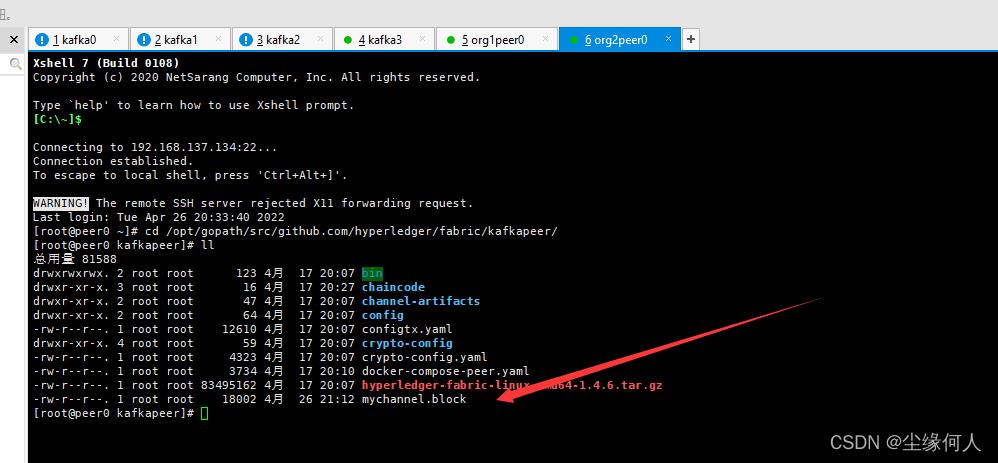
注意,这个时候,还是在org1pper0这台机器上进行操作
然后是安装链码,这个随便找个官方的那个example02的例子就行,我是放在/kafkapeer/chaincode/go/example02/这个目录下的。
docker exec -it cli bash
peer chaincode install -n mycc -p github.com/hyperledger/fabric/kafkapeer/chaincode/go/example02/ -v 1.0
然后我们实例化一下基本数据(因为刚才退出去了,所以orderer_ca这个指定的环境地址就没了,要重新写一遍,后面可以将这个写到docker的环境变量里面去):
ORDERER_CA=/opt/gopath/src/github.com/hyperledger/fabric/peer/crypto/ordererOrganizations/example.com/orderers/orderer0.example.com/msp/tlscacerts/tlsca.example.com-cert.pem
peer chaincode instantiate -o orderer0.example.com:7050 --tls --cafile $ORDERER_CA -C mychannel -n mycc -v 1.0 -c '"Args":["init","a","200","b","400"]' -P "OR ('Org1MSP.peer','Org2MSP.peer')"
接着查询:
peer chaincode query -C mychannel -n mycc -c '"Args":["query","a"]'
这个时候A的账户余额就出来了:

然后我们在org2peer0这台服务器上启动容器:
docker-compose -f docker-compose-peer.yaml up -d
随后进入:
docker exec -it cli bash
然后我们记下这个时候org2peer0上面启动容器的id,将我们mychannel.block的区块信息输进去:
docker cp /opt/gopath/src/github.com/hyperledger/fabric/kafkapeer/mychannel.block 79b2cc494c8d:/opt/gopath/src/github.com/hyperledger/fabric/peer/


然后再进入docker内部:
docker exec -it cli bash
这个时候我们就不用再创建channel了,因为这个区块信息已经包含了,我们现在需要做的只是加入channel:
peer channel join -b mychannel.block

接着我们就在这个org2peer0服务器安装链码,当然这里需要与之前的org1peer0上的链码保持一致,就是同一个地址的example02的go文件:
peer chaincode install -n mycc -p github.com/hyperledger/fabric/kafkapeer/chaincode/go/example02/ -v 1.0

然后我们测试一下,在org2peer0上面。试试A向B转账:
ORDERER_CA=/opt/gopath/src/github.com/hyperledger/fabric/peer/crypto/ordererOrganizations/example.com/orderers/orderer0.example.com/msp/tlscacerts/tlsca.example.com-cert.pem
peer chaincode invoke --tls --cafile $ORDERER_CA -C mychannel -n mycc -c '"Args":["invoke","a","b","20"]'

这个交易的时间可能会稍微久一点,耐心等待;其实在安装实例化链码,进行交易的时候都会通信一会,是正常现象。
然后我们再回到org1peer0这个服务器这里,执行上一步的查询:
peer chaincode query -C mychannel -n mycc -c '"Args":["query","a"]'
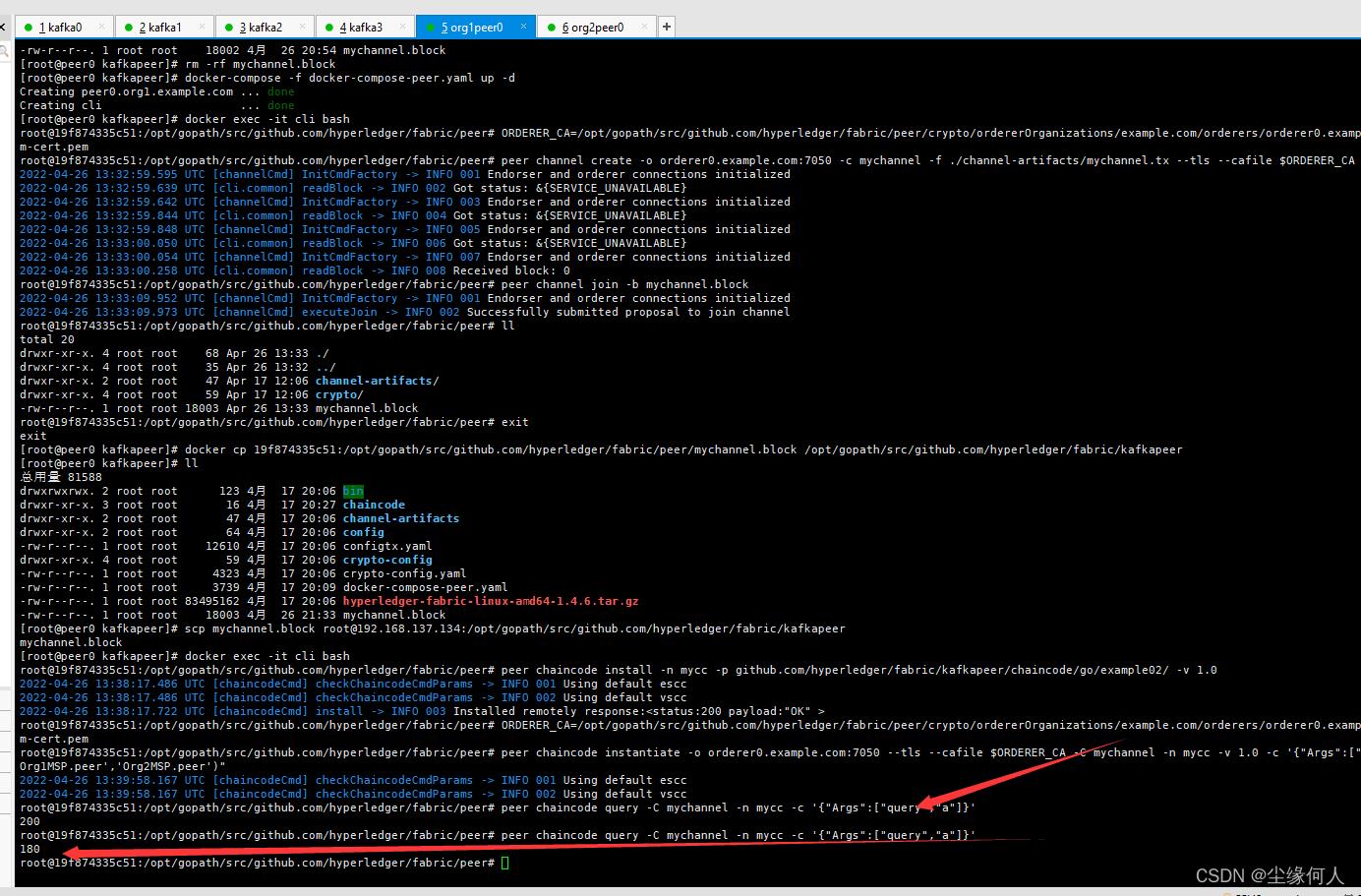
我们就会发现,刚才查询A的余额是200,在经历了org2peer0的转账操作之后,再一次查询就只有180了,这就是kafka集群模式下,多个peer中任意一个peer对区块链上数据进行维护,对于其他的peer来讲都是同步的。这里虽然只用了两台服务器,但无论我开不开那剩下两台,原理都是一样的,差不多这就是整个教程的结束。
下一步就是新建一个peer节点动态加入当前的集群。这里建议大家将每台服务器都备份或者整个镜像出来,毕竟忙活这么久了,万一要是有个什么不测就真的难受了。
HyperLedger Fabric 1.2 kafka生产环境部署(11.1)
11.1 Kafka模式简介
上一章介绍的Solo模式只存在一个排序(orderer)服务,是一种中心化结构,一旦排序(orderer)服务出现了问题,整个区块链网络将会崩溃,为了能在正式环境中稳定运行,需要对排序(orderer)服务采用集群方式,Hyperledger Fabric采用kafka方式实现排序(orderer)服务的集群,kafka模块被认为是半中心化结构。
顺便提一下,去中心化的BFT(拜占庭容错)排序(orderer)服务集群方式目前还在开发,还没有规定发布时间,将在1.x周期内发布,可以关注跟踪FAB-33的更新。
11.2 Kafka网络拓扑
Kafka模式通过Kafka集群和zookeeper集群保证数据的一致性,实现排序功能,网络拓扑图如下:

图:网络拓扑
Kafka模式由排序(orderer)服务、kafka集群和zookeeper集群组成。每个排序(orderer)服务相互之间不通信,只与kafka集群通信,kafka集群与zookeeper相互连接。
Fabric网络中的各节点(Peer)收到客户端发送的交易请求时,把交易信息发送给与其连接的排序(orderer)服务,交由排序(orderer)服务集群进行排序处理。
11.3 Kafka运行配置
Kafka生产环境部署案例采用三个排序(orderer)服务、四个kafka、三个zookeeper和四个节点(peer)组成,共准备八台服务器,每台服务器对应的服务如下表所示:
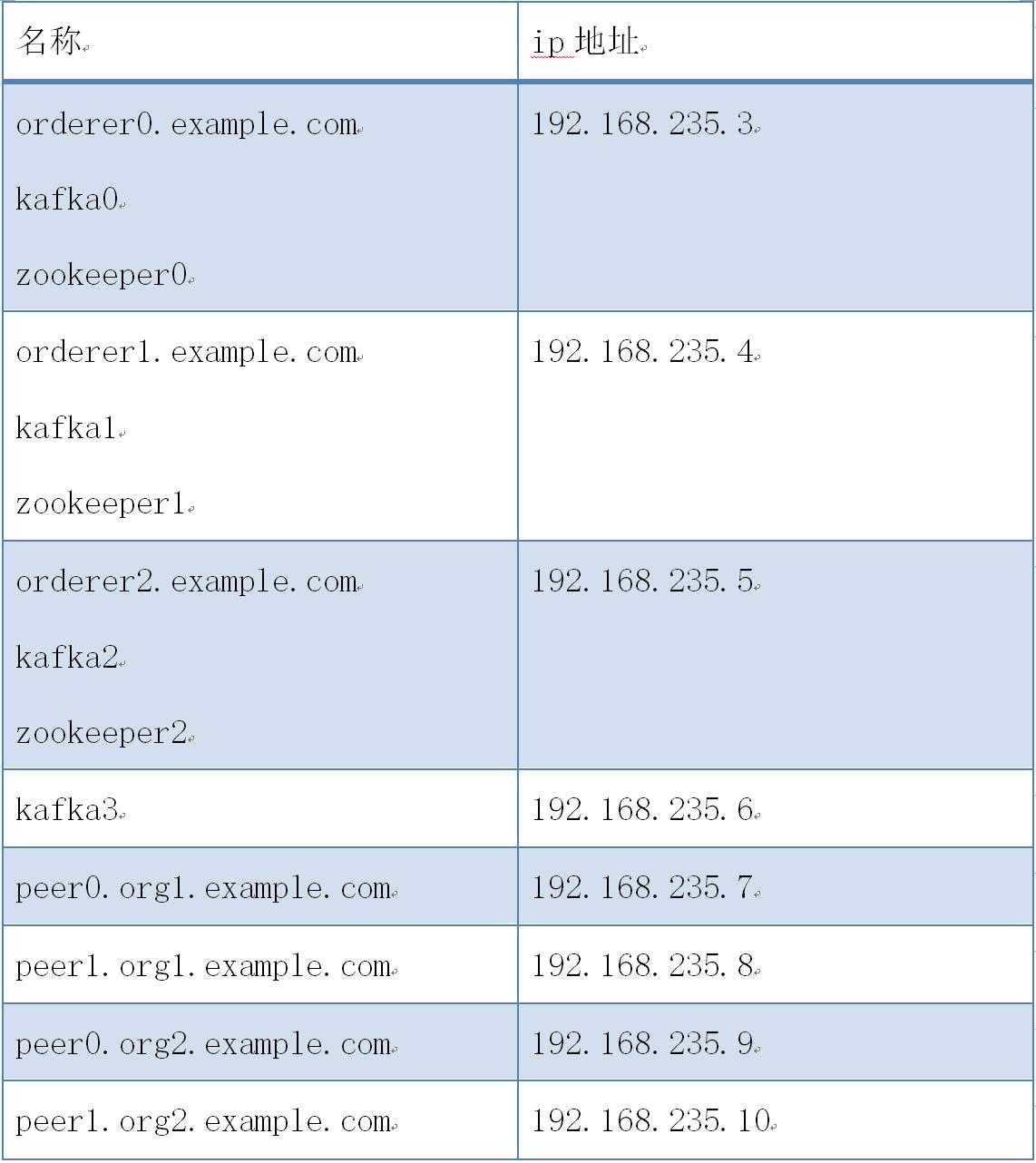
kafka案例网络拓扑图如下:
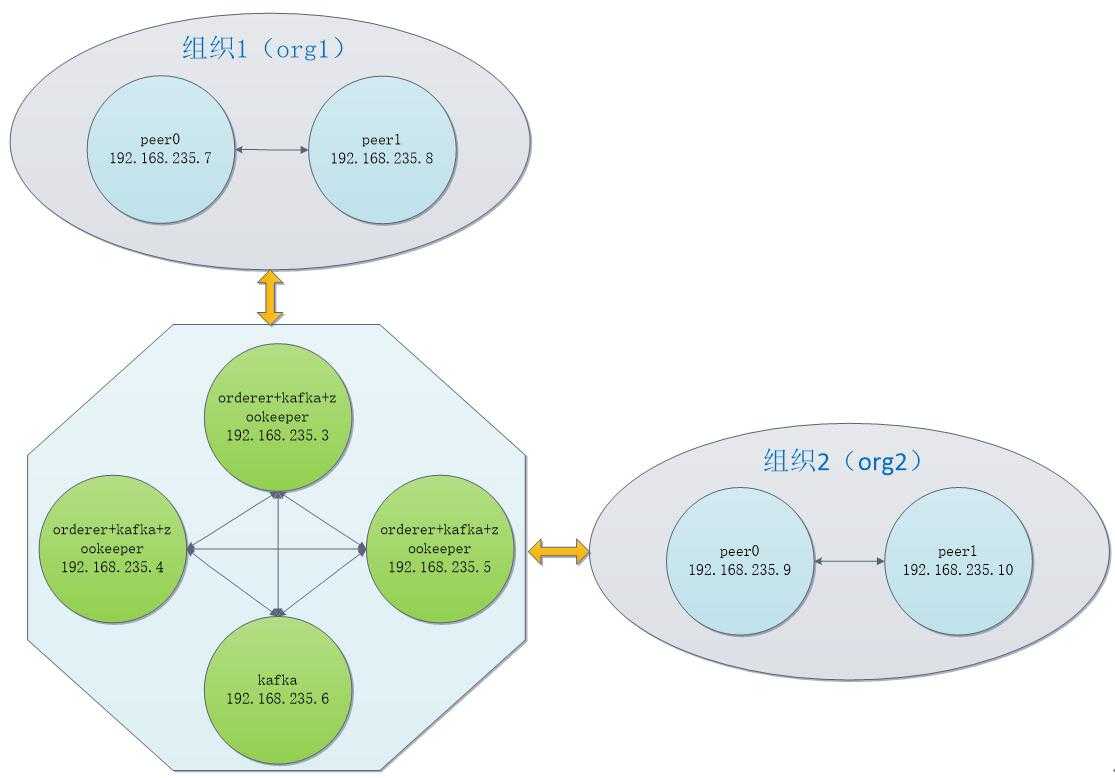
图:kafka案例网络拓扑
kafka案例部署步骤如下:
11.3.1 服务器(192.168.235.3)部署配置
1) 创建kafkapeer目录
# cd $GOPATH/src/github.com/hyperledger/fabric
# mkdir kafkapeer
# cd kafkapeer
2) 获取生成工具
把下载的hyperledger-fabric-linux-amd64-1.2.0.tar.gz二进制文件包解压,把其中的bin目录拷贝到multipeer目录下。
# chmod -R 777 ./bin
3) 准备生成证书和区块配置文件
配置crypto-config.yaml和configtx.yaml文件,拷贝到multipeer目录下。
4) 生成公私钥和证书
- crypto-config.yaml:
# Copyright IBM Corp. All Rights Reserved. # # SPDX-License-Identifier: Apache-2.0 # # --------------------------------------------------------------------------- # "OrdererOrgs" - Definition of organizations managing orderer nodes # --------------------------------------------------------------------------- OrdererOrgs: # --------------------------------------------------------------------------- # Orderer # --------------------------------------------------------------------------- - Name: Orderer Domain: example.com CA: Country: US Province: California Locality: San Francisco # --------------------------------------------------------------------------- # "Specs" - See PeerOrgs below for complete description # --------------------------------------------------------------------------- Specs: - Hostname: orderer0 - Hostname: orderer1 - Hostname: orderer2 # --------------------------------------------------------------------------- # "PeerOrgs" - Definition of organizations managing peer nodes # --------------------------------------------------------------------------- PeerOrgs: # --------------------------------------------------------------------------- # Org1 # --------------------------------------------------------------------------- - Name: Org1 Domain: org1.example.com EnableNodeOUs: true CA: Country: US Province: California Locality: San Francisco # --------------------------------------------------------------------------- # "Specs" # --------------------------------------------------------------------------- # Uncomment this section to enable the explicit definition of hosts in your # configuration. Most users will want to use Template, below # # Specs is an array of Spec entries. Each Spec entry consists of two fields: # - Hostname: (Required) The desired hostname, sans the domain. # - CommonName: (Optional) Specifies the template or explicit override for # the CN. By default, this is the template: # # "{{.Hostname}}.{{.Domain}}" # # which obtains its values from the Spec.Hostname and # Org.Domain, respectively. # --------------------------------------------------------------------------- # Specs: # - Hostname: foo # implicitly "foo.org1.example.com" # CommonName: foo27.org5.example.com # overrides Hostname-based FQDN set above # - Hostname: bar # - Hostname: baz # --------------------------------------------------------------------------- # "Template" # --------------------------------------------------------------------------- # Allows for the definition of 1 or more hosts that are created sequentially # from a template. By default, this looks like "peer%d" from 0 to Count-1. # You may override the number of nodes (Count), the starting index (Start) # or the template used to construct the name (Hostname). # # Note: Template and Specs are not mutually exclusive. You may define both # sections and the aggregate nodes will be created for you. Take care with # name collisions # --------------------------------------------------------------------------- Template: Count: 2 # Start: 5 # Hostname: {{.Prefix}}{{.Index}} # default # --------------------------------------------------------------------------- # "Users" # --------------------------------------------------------------------------- # Count: The number of user accounts _in addition_ to Admin # --------------------------------------------------------------------------- Users: Count: 1 # --------------------------------------------------------------------------- # Org2: See "Org1" for full specification # --------------------------------------------------------------------------- - Name: Org2 Domain: org2.example.com EnableNodeOUs: true CA: Country: US Province: California Locality: San Francisco Template: Count: 2 Users: Count: 1
- configtx.yaml
# Copyright IBM Corp. All Rights Reserved. # # SPDX-License-Identifier: Apache-2.0 # --- ################################################################################ # # Section: Organizations # # - This section defines the different organizational identities which will # be referenced later in the configuration. # ################################################################################ Organizations: # SampleOrg defines an MSP using the sampleconfig. It should never be used # in production but may be used as a template for other definitions - &OrdererOrg # DefaultOrg defines the organization which is used in the sampleconfig # of the fabric.git development environment Name: OrdererOrg # ID to load the MSP definition as ID: OrdererMSP # MSPDir is the filesystem path which contains the MSP configuration MSPDir: crypto-config/ordererOrganizations/example.com/msp # Policies defines the set of policies at this level of the config tree # For organization policies, their canonical path is usually # /Channel/<Application|Orderer>/<OrgName>/<PolicyName> Policies: Readers: Type: Signature Rule: "OR(‘OrdererMSP.member‘)" Writers: Type: Signature Rule: "OR(‘OrdererMSP.member‘)" Admins: Type: Signature Rule: "OR(‘OrdererMSP.admin‘)" - &Org1 # DefaultOrg defines the organization which is used in the sampleconfig # of the fabric.git development environment Name: Org1MSP # ID to load the MSP definition as ID: Org1MSP MSPDir: crypto-config/peerOrganizations/org1.example.com/msp # Policies defines the set of policies at this level of the config tree # For organization policies, their canonical path is usually # /Channel/<Application|Orderer>/<OrgName>/<PolicyName> Policies: Readers: Type: Signature Rule: "OR(‘Org1MSP.admin‘, ‘Org1MSP.peer‘, ‘Org1MSP.client‘)" Writers: Type: Signature Rule: "OR(‘Org1MSP.admin‘, ‘Org1MSP.client‘)" Admins: Type: Signature Rule: "OR(‘Org1MSP.admin‘)" AnchorPeers: # AnchorPeers defines the location of peers which can be used # for cross org gossip communication. Note, this value is only # encoded in the genesis block in the Application section context - Host: peer0.org1.example.com Port: 7051 - &Org2 # DefaultOrg defines the organization which is used in the sampleconfig # of the fabric.git development environment Name: Org2MSP # ID to load the MSP definition as ID: Org2MSP MSPDir: crypto-config/peerOrganizations/org2.example.com/msp # Policies defines the set of policies at this level of the config tree # For organization policies, their canonical path is usually # /Channel/<Application|Orderer>/<OrgName>/<PolicyName> Policies: Readers: Type: Signature Rule: "OR(‘Org2MSP.admin‘, ‘Org2MSP.peer‘, ‘Org2MSP.client‘)" Writers: Type: Signature Rule: "OR(‘Org2MSP.admin‘, ‘Org2MSP.client‘)" Admins: Type: Signature Rule: "OR(‘Org2MSP.admin‘)" AnchorPeers: # AnchorPeers defines the location of peers which can be used # for cross org gossip communication. Note, this value is only # encoded in the genesis block in the Application section context - Host: peer0.org2.example.com Port: 7051 ################################################################################ # # SECTION: Capabilities # # - This section defines the capabilities of fabric network. This is a new # concept as of v1.1.0 and should not be utilized in mixed networks with # v1.0.x peers and orderers. Capabilities define features which must be # present in a fabric binary for that binary to safely participate in the # fabric network. For instance, if a new MSP type is added, newer binaries # might recognize and validate the signatures from this type, while older # binaries without this support would be unable to validate those # transactions. This could lead to different versions of the fabric binaries # having different world states. Instead, defining a capability for a channel # informs those binaries without this capability that they must cease # processing transactions until they have been upgraded. For v1.0.x if any # capabilities are defined (including a map with all capabilities turned off) # then the v1.0.x peer will deliberately crash. # ################################################################################ Capabilities: # Channel capabilities apply to both the orderers and the peers and must be # supported by both. Set the value of the capability to true to require it. Global: &ChannelCapabilities # V1.1 for Global is a catchall flag for behavior which has been # determined to be desired for all orderers and peers running v1.0.x, # but the modification of which would cause incompatibilities. Users # should leave this flag set to true. V1_1: true # Orderer capabilities apply only to the orderers, and may be safely # manipulated without concern for upgrading peers. Set the value of the # capability to true to require it. Orderer: &OrdererCapabilities # V1.1 for Order is a catchall flag for behavior which has been # determined to be desired for all orderers running v1.0.x, but the # modification of which would cause incompatibilities. Users should # leave this flag set to true. V1_1: true # Application capabilities apply only to the peer network, and may be safely # manipulated without concern for upgrading orderers. Set the value of the # capability to true to require it. Application: &ApplicationCapabilities # V1.1 for Application is a catchall flag for behavior which has been # determined to be desired for all peers running v1.0.x, but the # modification of which would cause incompatibilities. Users should # leave this flag set to true. V1_2: true ################################################################################ # # SECTION: Application # # - This section defines the values to encode into a config transaction or # genesis block for application related parameters # ################################################################################ Application: &ApplicationDefaults # Organizations is the list of orgs which are defined as participants on # the application side of the network Organizations: # Policies defines the set of policies at this level of the config tree # For Application policies, their canonical path is # /Channel/Application/<PolicyName> Policies: Readers: Type: ImplicitMeta Rule: "ANY Readers" Writers: Type: ImplicitMeta Rule: "ANY Writers" Admins: Type: ImplicitMeta Rule: "MAJORITY Admins" # Capabilities describes the application level capabilities, see the # dedicated Capabilities section elsewhere in this file for a full # description Capabilities: <<: *ApplicationCapabilities ################################################################################ # # SECTION: Orderer # # - This section defines the values to encode into a config transaction or # genesis block for orderer related parameters # ################################################################################ Orderer: &OrdererDefaults # Orderer Type: The orderer implementation to start # Available types are "solo" and "kafka" OrdererType: kafka Addresses: - orderer0.example.com:7050 - orderer1.example.com:7050 - orderer2.example.com:7050 # Batch Timeout: The amount of time to wait before creating a batch BatchTimeout: 2s # Batch Size: Controls the number of messages batched into a block BatchSize: # Max Message Count: The maximum number of messages to permit in a batch MaxMessageCount: 10 # Absolute Max Bytes: The absolute maximum number of bytes allowed for # the serialized messages in a batch. AbsoluteMaxBytes: 98 MB # Preferred Max Bytes: The preferred maximum number of bytes allowed for # the serialized messages in a batch. A message larger than the preferred # max bytes will result in a batch larger than preferred max bytes. PreferredMaxBytes: 512 KB Kafka: # Brokers: A list of Kafka brokers to which the orderer connects. Edit # this list to identify the brokers of the ordering service. # NOTE: Use IP:port notation. Brokers: - kafka0:9092 - kafka1:9092 - kafka2:9092 - kafka3:9092 # Organizations is the list of orgs which are defined as participants on # the orderer side of the network Organizations: # Policies defines the set of policies at this level of the config tree # For Orderer policies, their canonical path is # /Channel/Orderer/<PolicyName> Policies: Readers: Type: ImplicitMeta Rule: "ANY Readers" Writers: Type: ImplicitMeta Rule: "ANY Writers" Admins: Type: ImplicitMeta Rule: "MAJORITY Admins" # BlockValidation specifies what signatures must be included in the block # from the orderer for the peer to validate it. BlockValidation: Type: ImplicitMeta Rule: "ANY Writers" # Capabilities describes the orderer level capabilities, see the # dedicated Capabilities section elsewhere in this file for a full # description Capabilities: <<: *OrdererCapabilities ################################################################################ # # CHANNEL # # This section defines the values to encode into a config transaction or # genesis block for channel related parameters. # ################################################################################ Channel: &ChannelDefaults # Policies defines the set of policies at this level of the config tree # For Channel policies, their canonical path is # /Channel/<PolicyName> Policies: # Who may invoke the ‘Deliver‘ API Readers: Type: ImplicitMeta Rule: "ANY Readers" # Who may invoke the ‘Broadcast‘ API Writers: Type: ImplicitMeta Rule: "ANY Writers" # By default, who may modify elements at this config level Admins: Type: ImplicitMeta Rule: "MAJORITY Admins" # Capabilities describes the channel level capabilities, see the # dedicated Capabilities section elsewhere in this file for a full # description Capabilities: <<: *ChannelCapabilities ################################################################################ # # Profile # # - Different configuration profiles may be encoded here to be specified # as parameters to the configtxgen tool # ################################################################################ Profiles: TwoOrgsOrdererGenesis: <<: *ChannelDefaults Orderer: <<: *OrdererDefaults Organizations: - *OrdererOrg Consortiums: SampleConsortium: Organizations: - *Org1 - *Org2 TwoOrgsChannel: Consortium: SampleConsortium Application: <<: *ApplicationDefaults Organizations: - *Org1 - *Org2
5) 生成公私钥和证书
# ./bin/cryptogen generate --config=./crypto-config.yaml
6) 生成创世区块
# mkdir channel-artifacts
# ./bin/configtxgen -profile TwoOrgsOrdererGenesis -outputBlock ./channel-artifacts/genesis.block
7) 生成通道配置区块
# ./bin/configtxgen -profile TwoOrgsChannel -outputCreateChannelTx ./channel-artifacts/mychannel.tx -channelID mychannel
8) 拷贝生成文件到其它服务器
# cd .. # scp -r kafkapeer [email protected]192.168.235.4:/opt/gopath/src/github.com/hyperledger/fabric # scp -r kafkapeer [email protected]192.168.235.5:/opt/gopath/src/github.com/hyperledger/fabric # scp -r kafkapeer [email protected]192.168.235.6:/opt/gopath/src/github.com/hyperledger/fabric # scp -r kafkapeer [email protected]192.168.235.7:/opt/gopath/src/github.com/hyperledger/fabric # scp -r kafkapeer [email protected]192.168.235.8:/opt/gopath/src/github.com/hyperledger/fabric # scp -r kafkapeer [email protected]192.168.235.9:/opt/gopath/src/github.com/hyperledger/fabric # scp -r kafkapeer [email protected]192.168.235.10:/opt/gopath/src/github.com/hyperledger/fabric
9) 准备zookeeper配置文件
配置docker-compose-zookeeper.yaml文件,拷贝到kafkapeer目录下。
# Copyright IBM Corp. All Rights Reserved. # # SPDX-License-Identifier: Apache-2.0 # version: ‘2‘ services: zookeeper0: container_name: zookeeper0 hostname: zookeeper0 image: hyperledger/fabric-zookeeper restart: always environment: - ZOO_MY_ID=1 - ZOO_SERVERS=server.1=zookeeper0:2888:3888 server.2=zookeeper1:2888:3888 server.3=zookeeper2:2888:3888 ports: - 2181:2181 - 2888:2888 - 3888:3888 extra_hosts: - "zookeeper0:192.168.235.3" - "zookeeper1:192.168.235.4" - "zookeeper2:192.168.235.5" - "kafka0:192.168.235.3" - "kafka1:192.168.235.4" - "kafka2:192.168.235.5" - "kafka3:192.168.235.6"
10) 准备kafka配置文件
配置docker-compose-kafka.yaml文件,拷贝到kafkapeer目录下。
# Copyright IBM Corp. All Rights Reserved. # # SPDX-License-Identifier: Apache-2.0 # version: ‘2‘ services: kafka0: container_name: kafka0 hostname: kafka0 image: hyperledger/fabric-kafka restart: always environment: - KAFKA_MESSAGE_MAX_BYTES=103809024 # 99 * 1024 * 1024 B - KAFKA_REPLICA_FETCH_MAX_BYTES=103809024 # 99 * 1024 * 1024 B - KAFKA_UNCLEAN_LEADER_ELECTION_ENABLE=false environment: - KAFKA_BROKER_ID=1 - KAFKA_MIN_INSYNC_REPLICAS=2 - KAFKA_DEFAULT_REPLICATION_FACTOR=3 - KAFKA_ZOOKEEPER_CONNECT=zookeeper0:2181,zookeeper1:2181,zookeeper2:2181 ports: - 9092:9092 extra_hosts: - "zookeeper0:192.168.235.3" - "zookeeper1:192.168.235.4" - "zookeeper2:192.168.235.5" - "kafka0:192.168.235.3" - "kafka1:192.168.235.4" - "kafka2:192.168.235.5" - "kafka3:192.168.235.6"
11) 准备orderer配置文件
配置docker-compose-orderer.yaml文件,拷贝到kafkapeer目录下。
# Copyright IBM Corp. All Rights Reserved. # # SPDX-License-Identifier: Apache-2.0 # version: ‘2‘ services: orderer0.example.com: container_name: orderer0.example.com image: hyperledger/fabric-orderer environment: - ORDERER_GENERAL_LOGLEVEL=debug - ORDERER_GENERAL_LISTENADDRESS=0.0.0.0 - ORDERER_GENERAL_GENESISMETHOD=file - ORDERER_GENERAL_GENESISFILE=/var/hyperledger/orderer/orderer.genesis.block - ORDERER_GENERAL_LOCALMSPID=OrdererMSP - ORDERER_GENERAL_LOCALMSPDIR=/var/hyperledger/orderer/msp # enabled TLS - ORDERER_GENERAL_TLS_ENABLED=true - ORDERER_GENERAL_TLS_PRIVATEKEY=/var/hyperledger/orderer/tls/server.key - ORDERER_GENERAL_TLS_CERTIFICATE=/var/hyperledger/orderer/tls/server.crt - ORDERER_GENERAL_TLS_ROOTCAS=[/var/hyperledger/orderer/tls/ca.crt] - ORDERER_KAFKA_RETRY_LONGINTERVAL=10s - ORDERER_KAFKA_RETRY_LONGTOTAL=100s - ORDERER_KAFKA_RETRY_SHORTINTERVAL=1s - ORDERER_KAFKA_RETRY_SHORTTOTAL=30s - ORDERER_KAFKA_VERBOSE=true working_dir: /opt/gopath/src/github.com/hyperledger/fabric command: orderer volumes: - ./channel-artifacts/genesis.block:/var/hyperledger/orderer/orderer.genesis.block - ./crypto-config/ordererOrganizations/example.com/orderers/orderer0.example.com/msp:/var/hyperledger/orderer/msp - ./crypto-config/ordererOrganizations/example.com/orderers/orderer0.example.com/tls/:/var/hyperledger/orderer/tls ports: - 7050:7050 extra_hosts: - "kafka0:192.168.235.3" - "kafka1:192.168.235.4" - "kafka2:192.168.235.5" - "kafka3:192.168.235.6"
11.3.2 服务器(192.168.235.4)部署配置
1) 准备zookeeper配置文件
配置docker-compose-zookeeper.yaml文件,拷贝到kafkapeer目录下。
# Copyright IBM Corp. All Rights Reserved. # # SPDX-License-Identifier: Apache-2.0 # version: ‘2‘ services: zookeeper1: container_name: zookeeper1 hostname: zookeeper1 image: hyperledger/fabric-zookeeper restart: always environment: - ZOO_MY_ID=2 - ZOO_SERVERS=server.1=zookeeper0:2888:3888 server.2=zookeeper1:2888:3888 server.3=zookeeper2:2888:3888 ports: - 2181:2181 - 2888:2888 - 3888:3888 extra_hosts: - "zookeeper0:192.168.235.3" - "zookeeper1:192.168.235.4" - "zookeeper2:192.168.235.5" - "kafka0:192.168.235.3" - "kafka1:192.168.235.4" - "kafka2:192.168.235.5" - "kafka3:192.168.235.6"
2) 准备kafka配置文件
配置docker-compose-kafka.yaml文件,拷贝到kafkapeer目录下。
# Copyright IBM Corp. All Rights Reserved. # # SPDX-License-Identifier: Apache-2.0 # version: ‘2‘ services: kafka1: container_name: kafka1 hostname: kafka1 image: hyperledger/fabric-kafka restart: always environment: - KAFKA_MESSAGE_MAX_BYTES=103809024 # 99 * 1024 * 1024 B - KAFKA_REPLICA_FETCH_MAX_BYTES=103809024 # 99 * 1024 * 1024 B - KAFKA_UNCLEAN_LEADER_ELECTION_ENABLE=false environment: - KAFKA_BROKER_ID=2 - KAFKA_MIN_INSYNC_REPLICAS=2 - KAFKA_DEFAULT_REPLICATION_FACTOR=3 - KAFKA_ZOOKEEPER_CONNECT=zookeeper0:2181,zookeeper1:2181,zookeeper2:2181 ports: - 9092:9092 extra_hosts: - "zookeeper0:192.168.235.3" - "zookeeper1:192.168.235.4" - "zookeeper2:192.168.235.5" - "kafka0:192.168.235.3" - "kafka1:192.168.235.4" - "kafka2:192.168.235.5" - "kafka3:192.168.235.6"
3) 准备orderer配置文件
配置docker-compose-orderer.yaml文件,拷贝到kafkapeer目录下。
# Copyright IBM Corp. All Rights Reserved. # # SPDX-License-Identifier: Apache-2.0 # version: ‘2‘ services: orderer1.example.com: container_name: orderer1.example.com image: hyperledger/fabric-orderer environment: - ORDERER_GENERAL_LOGLEVEL=debug - ORDERER_GENERAL_LISTENADDRESS=0.0.0.0 - ORDERER_GENERAL_GENESISMETHOD=file - ORDERER_GENERAL_GENESISFILE=/var/hyperledger/orderer/orderer.genesis.block - ORDERER_GENERAL_LOCALMSPID=OrdererMSP - ORDERER_GENERAL_LOCALMSPDIR=/var/hyperledger/orderer/msp # enabled TLS - ORDERER_GENERAL_TLS_ENABLED=true - ORDERER_GENERAL_TLS_PRIVATEKEY=/var/hyperledger/orderer/tls/server.key - ORDERER_GENERAL_TLS_CERTIFICATE=/var/hyperledger/orderer/tls/server.crt - ORDERER_GENERAL_TLS_ROOTCAS=[/var/hyperledger/orderer/tls/ca.crt] - ORDERER_KAFKA_RETRY_LONGINTERVAL=10s - ORDERER_KAFKA_RETRY_LONGTOTAL=100s - ORDERER_KAFKA_RETRY_SHORTINTERVAL=1s - ORDERER_KAFKA_RETRY_SHORTTOTAL=30s - ORDERER_KAFKA_VERBOSE=true working_dir: /opt/gopath/src/github.com/hyperledger/fabric command: orderer volumes: - ./channel-artifacts/genesis.block:/var/hyperledger/orderer/orderer.genesis.block - ./crypto-config/ordererOrganizations/example.com/orderers/orderer1.example.com/msp:/var/hyperledger/orderer/msp - ./crypto-config/ordererOrganizations/example.com/orderers/orderer1.example.com/tls/:/var/hyperledger/orderer/tls ports: - 7050:7050 extra_hosts: - "kafka0:192.168.235.3" - "kafka1:192.168.235.4" - "kafka2:192.168.235.5" - "kafka3:192.168.235.6"
11.3.3 服务器(192.168.235.5)部署配置
1) 准备zookeeper配置文件
配置docker-compose-zookeeper.yaml文件,拷贝到kafkapeer目录下。
# Copyright IBM Corp. All Rights Reserved. # # SPDX-License-Identifier: Apache-2.0 # version: ‘2‘ services: zookeeper2: container_name: zookeeper2 hostname: zookeeper2 image: hyperledger/fabric-zookeeper restart: always environment: - ZOO_MY_ID=3 - ZOO_SERVERS=server.1=zookeeper0:2888:3888 server.2=zookeeper1:2888:3888 server.3=zookeeper2:2888:3888 ports: - 2181:2181 - 2888:2888 - 3888:3888 extra_hosts: - "zookeeper0:192.168.235.3" - "zookeeper1:192.168.235.4" - "zookeeper2:192.168.235.5" - "kafka0:192.168.235.3" - "kafka1:192.168.235.4" - "kafka2:192.168.235.5" - "kafka3:192.168.235.6"
2) 准备kafka配置文件
配置docker-compose-kafka.yaml文件,拷贝到kafkapeer目录下。
# Copyright IBM Corp. All Rights Reserved. # # SPDX-License-Identifier: Apache-2.0 # version: ‘2‘ services: kafka2: container_name: kafka2 hostname: kafka2 image: hyperledger/fabric-kafka restart: always environment: - KAFKA_MESSAGE_MAX_BYTES=103809024 # 99 * 1024 * 1024 B - KAFKA_REPLICA_FETCH_MAX_BYTES=103809024 # 99 * 1024 * 1024 B - KAFKA_UNCLEAN_LEADER_ELECTION_ENABLE=false environment: - KAFKA_BROKER_ID=3 - KAFKA_MIN_INSYNC_REPLICAS=2 - KAFKA_DEFAULT_REPLICATION_FACTOR=3 - KAFKA_ZOOKEEPER_CONNECT=zookeeper0:2181,zookeeper1:2181,zookeeper2:2181 ports: - 9092:9092 extra_hosts: - "zookeeper0:192.168.235.3" - "zookeeper1:192.168.235.4" - "zookeeper2:192.168.235.5" - "kafka0:192.168.235.3" - "kafka1:192.168.235.4" - "kafka2:192.168.235.5" - "kafka3:192.168.235.6"
3) 准备orderer配置文件
配置docker-compose-orderer.yaml文件,拷贝到kafkapeer目录下。
# Copyright IBM Corp. All Rights Reserved. # # SPDX-License-Identifier: Apache-2.0 # version: ‘2‘ services: orderer2.example.com: container_name: orderer2.example.com image: hyperledger/fabric-orderer environment: - ORDERER_GENERAL_LOGLEVEL=debug - ORDERER_GENERAL_LISTENADDRESS=0.0.0.0 - ORDERER_GENERAL_GENESISMETHOD=file - ORDERER_GENERAL_GENESISFILE=/var/hyperledger/orderer/orderer.genesis.block - ORDERER_GENERAL_LOCALMSPID=OrdererMSP - ORDERER_GENERAL_LOCALMSPDIR=/var/hyperledger/orderer/msp # enabled TLS - ORDERER_GENERAL_TLS_ENABLED=true - ORDERER_GENERAL_TLS_PRIVATEKEY=/var/hyperledger/orderer/tls/server.key - ORDERER_GENERAL_TLS_CERTIFICATE=/var/hyperledger/orderer/tls/server.crt - ORDERER_GENERAL_TLS_ROOTCAS=[/var/hyperledger/orderer/tls/ca.crt] - ORDERER_KAFKA_RETRY_LONGINTERVAL=10s - ORDERER_KAFKA_RETRY_LONGTOTAL=100s - ORDERER_KAFKA_RETRY_SHORTINTERVAL=1s - ORDERER_KAFKA_RETRY_SHORTTOTAL=30s - ORDERER_KAFKA_VERBOSE=true working_dir: /opt/gopath/src/github.com/hyperledger/fabric command: orderer volumes: - ./channel-artifacts/genesis.block:/var/hyperledger/orderer/orderer.genesis.block - ./crypto-config/ordererOrganizations/example.com/orderers/orderer2.example.com/msp:/var/hyperledger/orderer/msp - ./crypto-config/ordererOrganizations/example.com/orderers/orderer2.example.com/tls/:/var/hyperledger/orderer/tls ports: - 7050:7050 extra_hosts: - "kafka0:192.168.235.3" - "kafka1:192.168.235.4" - "kafka2:192.168.235.5" - "kafka3:192.168.235.6"
11.3.4 服务器(192.168.235.6)部署配置
1) 准备kafka配置文件
配置docker-compose-kafka.yaml文件,拷贝到kafkapeer目录下。
# Copyright IBM Corp. All Rights Reserved. # # SPDX-License-Identifier: Apache-2.0 # version: ‘2‘ services: kafka3: container_name: kafka3 hostname: kafka3 image: hyperledger/fabric-kafka restart: always environment: - KAFKA_MESSAGE_MAX_BYTES=103809024 # 99 * 1024 * 1024 B - KAFKA_REPLICA_FETCH_MAX_BYTES=103809024 # 99 * 1024 * 1024 B - KAFKA_UNCLEAN_LEADER_ELECTION_ENABLE=false environment: - KAFKA_BROKER_ID=4 - KAFKA_MIN_INSYNC_REPLICAS=2 - KAFKA_DEFAULT_REPLICATION_FACTOR=3 - KAFKA_ZOOKEEPER_CONNECT=zookeeper0:2181,zookeeper1:2181,zookeeper2:2181 ports: - 9092:9092 extra_hosts: - "zookeeper0:192.168.235.3" - "zookeeper1:192.168.235.4" - "zookeeper2:192.168.235.5" - "kafka0:192.168.235.3" - "kafka1:192.168.235.4" - "kafka2:192.168.235.5" - "kafka3:192.168.235.6"
11.3.5 服务器(192.168.235.7)部署配置
1) 准备peer配置文件
配置docker-compose-peer.yaml文件,拷贝到kafkapeer目录下。
# All elements in this file should depend on the docker-compose-base.yaml # Provided fabric peer node version: ‘2‘ services: peer0.org1.example.com: container_name: peer0.org1.example.com hostname: peer0.org1.example.com image: hyperledger/fabric-peer environment: - CORE_PEER_ID=peer0.org1.example.com - CORE_PEER_ADDRESS=peer0.org1.example.com:7051 - CORE_PEER_CHAINCODELISTENADDRESS=peer0.org1.example.com:7052 - CORE_PEER_GOSSIP_EXTERNALENDPOINT=peer0.org1.example.com:7051 - CORE_PEER_LOCALMSPID=Org1MSP - CORE_VM_ENDPOINT=unix:///host/var/run/docker.sock # the following setting starts chaincode containers on the same # bridge network as the peers # https://docs.docker.com/compose/networking/ #- CORE_LOGGING_LEVEL=ERROR - CORE_LOGGING_LEVEL=DEBUG - CORE_PEER_GOSSIP_USELEADERELECTION=true - CORE_PEER_GOSSIP_ORGLEADER=false - CORE_PEER_PROFILE_ENABLED=true - CORE_PEER_TLS_ENABLED=true - CORE_PEER_TLS_CERT_FILE=/etc/hyperledger/fabric/tls/server.crt - CORE_PEER_TLS_KEY_FILE=/etc/hyperledger/fabric/tls/server.key - CORE_PEER_TLS_ROOTCERT_FILE=/etc/hyperledger/fabric/tls/ca.crt working_dir: /opt/gopath/src/github.com/hyperledger/fabric/peer command: peer node start volumes: - /var/run/:/host/var/run/ - ./crypto-config/peerOrganizations/org1.example.com/peers/peer0.org1.example.com/msp:/etc/hyperledger/fabric/msp - ./crypto-config/peerOrganizations/org1.example.com/peers/peer0.org1.example.com/tls:/etc/hyperledger/fabric/tls ports: - 7051:7051 - 7052:7052 - 7053:7053 extra_hosts: - "orderer0.example.com:192.168.235.3" - "orderer1.example.com:192.168.235.4" - "orderer2.example.com:192.168.235.5" cli: container_name: cli image: hyperledger/fabric-tools tty: true environment: - GOPATH=/opt/gopath - CORE_VM_ENDPOINT=unix:///host/var/run/docker.sock # - CORE_LOGGING_LEVEL=ERROR - CORE_LOGGING_LEVEL=DEBUG - CORE_PEER_ID=cli - CORE_PEER_ADDRESS=peer0.org1.example.com:7051 - CORE_PEER_LOCALMSPID=Org1MSP - CORE_PEER_TLS_ENABLED=true - CORE_PEER_TLS_CERT_FILE=/opt/gopath/src/github.com/hyperledger/fabric/peer/crypto/peerOrganizations/org1.example.com/peers/peer0.org1.example.com/tls/server.crt - CORE_PEER_TLS_KEY_FILE=/opt/gopath/src/github.com/hyperledger/fabric/peer/crypto/peerOrganizations/org1.example.com/peers/peer0.org1.example.com/tls/server.key - CORE_PEER_TLS_ROOTCERT_FILE=/opt/gopath/src/github.com/hyperledger/fabric/peer/crypto/peerOrganizations/org1.example.com/peers/peer0.org1.example.com/tls/ca.crt - CORE_PEER_MSPCONFIGPATH=/opt/gopath/src/github.com/hyperledger/fabric/peer/crypto/peerOrganizations/org1.example.com/users/[email protected]/msp working_dir: /opt/gopath/src/github.com/hyperledger/fabric/peer volumes: - /var/run/:/host/var/run/ - ./chaincode/go/:/opt/gopath/src/github.com/hyperledger/fabric/kafkapeer/chaincode/go - ./crypto-config:/opt/gopath/src/github.com/hyperledger/fabric/peer/crypto/ - ./channel-artifacts:/opt/gopath/src/github.com/hyperledger/fabric/peer/channel-artifacts extra_hosts: - "orderer0.example.com:192.168.235.3" - "orderer1.example.com:192.168.235.4" - "orderer2.example.com:192.168.235.5" - "peer0.org1.example.com:192.168.235.7" - "peer1.org1.example.com:192.168.235.8" - "peer0.org2.example.com:192.168.235.9" - "peer1.org2.example.com:192.168.235.10"
11.3.6 服务器(192.168.235.8)部署配置
1) 准备peer配置文件
配置docker-compose-peer.yaml文件,拷贝到kafkapeer目录下。
# All elements in this file should depend on the docker-compose-base.yaml # Provided fabric peer node version: ‘2‘ services: peer1.org1.example.com: container_name: peer1.org1.example.com hostname: peer1.org1.example.com image: hyperledger/fabric-peer environment: - CORE_PEER_ID=peer1.org1.example.com - CORE_PEER_ADDRESS=peer1.org1.example.com:7051 - CORE_PEER_CHAINCODELISTENADDRESS=peer1.org1.example.com:7052 - CORE_PEER_GOSSIP_EXTERNALENDPOINT=peer1.org1.example.com:7051 - CORE_PEER_LOCALMSPID=Org1MSP - CORE_VM_ENDPOINT=unix:///host/var/run/docker.sock # the following setting starts chaincode containers on the same # bridge network as the peers # https://docs.docker.com/compose/networking/ #- CORE_LOGGING_LEVEL=ERROR - CORE_LOGGING_LEVEL=DEBUG - CORE_PEER_GOSSIP_USELEADERELECTION=true - CORE_PEER_GOSSIP_ORGLEADER=false - CORE_PEER_PROFILE_ENABLED=true - CORE_PEER_TLS_ENABLED=true - CORE_PEER_TLS_CERT_FILE=/etc/hyperledger/fabric/tls/server.crt - CORE_PEER_TLS_KEY_FILE=/etc/hyperledger/fabric/tls/server.key - CORE_PEER_TLS_ROOTCERT_FILE=/etc/hyperledger/fabric/tls/ca.crt working_dir: /opt/gopath/src/github.com/hyperledger/fabric/peer command: peer node start volumes: - /var/run/:/host/var/run/ - ./crypto-config/peerOrganizations/org1.example.com/peers/peer1.org1.example.com/msp:/etc/hyperledger/fabric/msp - ./crypto-config/peerOrganizations/org1.example.com/peers/peer1.org1.example.com/tls:/etc/hyperledger/fabric/tls ports: - 7051:7051 - 7052:7052 - 7053:7053 extra_hosts: - "orderer0.example.com:192.168.235.3" - "orderer1.example.com:192.168.235.4" - "orderer2.example.com:192.168.235.5" cli: container_name: cli image: hyperledger/fabric-tools tty: true environment: - GOPATH=/opt/gopath - CORE_VM_ENDPOINT=unix:///host/var/run/docker.sock # - CORE_LOGGING_LEVEL=ERROR - CORE_LOGGING_LEVEL=DEBUG - CORE_PEER_ID=cli - CORE_PEER_ADDRESS=peer1.org1.example.com:7051 - CORE_PEER_LOCALMSPID=Org1MSP - CORE_PEER_TLS_ENABLED=true - CORE_PEER_TLS_CERT_FILE=/opt/gopath/src/github.com/hyperledger/fabric/peer/crypto/peerOrganizations/org1.example.com/peers/peer1.org1.example.com/tls/server.crt - CORE_PEER_TLS_KEY_FILE=/opt/gopath/src/github.com/hyperledger/fabric/peer/crypto/peerOrganizations/org1.example.com/peers/peer1.org1.example.com/tls/server.key - CORE_PEER_TLS_ROOTCERT_FILE=/opt/gopath/src/github.com/hyperledger/fabric/peer/crypto/peerOrganizations/org1.example.com/peers/peer1.org1.example.com/tls/ca.crt - CORE_PEER_MSPCONFIGPATH=/opt/gopath/src/github.com/hyperledger/fabric/peer/crypto/peerOrganizations/org1.example.com/users/[email protected]/msp working_dir: /opt/gopath/src/github.com/hyperledger/fabric/peer volumes: - /var/run/:/host/var/run/ - ./chaincode/go/:/opt/gopath/src/github.com/hyperledger/fabric/kafkapeer/chaincode/go - ./crypto-config:/opt/gopath/src/github.com/hyperledger/fabric/peer/crypto/ - ./channel-artifacts:/opt/gopath/src/github.com/hyperledger/fabric/peer/channel-artifacts extra_hosts: - "orderer0.example.com:192.168.235.3" - "orderer1.example.com:192.168.235.4" - "orderer2.example.com:192.168.235.5" - "peer0.org1.example.com:192.168.235.7" - "peer1.org1.example.com:192.168.235.8" - "peer0.org2.example.com:192.168.235.9" - "peer1.org2.example.com:192.168.235.10"
11.3.7 服务器(192.168.235.9)部署配置
1) 准备peer配置文件
配置docker-compose-peer.yaml文件,拷贝到kafkapeer目录下。
# All elements in this file should depend on the docker-compose-base.yaml # Provided fabric peer node version: ‘2‘ services: peer0.org2.example.com: container_name: peer0.org2.example.com hostname: peer0.org2.example.com image: hyperledger/fabric-peer environment: - CORE_PEER_ID=peer0.org2.example.com - CORE_PEER_ADDRESS=peer0.org2.example.com:7051 - CORE_PEER_CHAINCODELISTENADDRESS=peer0.org2.example.com:7052 - CORE_PEER_GOSSIP_EXTERNALENDPOINT=peer0.org2.example.com:7051 - CORE_PEER_LOCALMSPID=Org2MSP - CORE_VM_ENDPOINT=unix:///host/var/run/docker.sock # the following setting starts chaincode containers on the same # bridge network as the peers # https://docs.docker.com/compose/networking/ #- CORE_LOGGING_LEVEL=ERROR - CORE_LOGGING_LEVEL=DEBUG - CORE_PEER_GOSSIP_USELEADERELECTION=true - CORE_PEER_GOSSIP_ORGLEADER=false - CORE_PEER_PROFILE_ENABLED=true - CORE_PEER_TLS_ENABLED=true - CORE_PEER_TLS_CERT_FILE=/etc/hyperledger/fabric/tls/server.crt - CORE_PEER_TLS_KEY_FILE=/etc/hyperledger/fabric/tls/server.key - CORE_PEER_TLS_ROOTCERT_FILE=/etc/hyperledger/fabric/tls/ca.crt working_dir: /opt/gopath/src/github.com/hyperledger/fabric/peer command: peer node start volumes: - /var/run/:/host/var/run/ - ./crypto-config/peerOrganizations/org2.example.com/peers/peer0.org2.example.com/msp:/etc/hyperledger/fabric/msp - ./crypto-config/peerOrganizations/org2.example.com/peers/peer0.org2.example.com/tls:/etc/hyperledger/fabric/tls ports: - 7051:7051 - 7052:7052 - 7053:7053 extra_hosts: - "orderer0.example.com:192.168.235.3" - "orderer1.example.com:192.168.235.4" - "orderer2.example.com:192.168.235.5" cli: container_name: cli image: hyperledger/fabric-tools tty: true environment: - GOPATH=/opt/gopath - CORE_VM_ENDPOINT=unix:///host/var/run/docker.sock # - CORE_LOGGING_LEVEL=ERROR - CORE_LOGGING_LEVEL=DEBUG - CORE_PEER_ID=cli - CORE_PEER_ADDRESS=peer0.org2.example.com:7051 - CORE_PEER_LOCALMSPID=Org2MSP - CORE_PEER_TLS_ENABLED=true - CORE_PEER_TLS_CERT_FILE=/opt/gopath/src/github.com/hyperledger/fabric/peer/crypto/peerOrganizations/org2.example.com/peers/peer0.org2.example.com/tls/server.crt - CORE_PEER_TLS_KEY_FILE=/opt/gopath/src/github.com/hyperledger/fabric/peer/crypto/peerOrganizations/org2.example.com/peers/peer0.org2.example.com/tls/server.key - CORE_PEER_TLS_ROOTCERT_FILE=/opt/gopath/src/github.com/hyperledger/fabric/peer/crypto/peerOrganizations/org2.example.com/peers/peer0.org2.example.com/tls/ca.crt - CORE_PEER_MSPCONFIGPATH=/opt/gopath/src/github.com/hyperledger/fabric/peer/crypto/peerOrganizations/org2.example.com/users/[email protected]/msp working_dir: /opt/gopath/src/github.com/hyperledger/fabric/peer volumes: - /var/run/:/host/var/run/ - ./chaincode/go/:/opt/gopath/src/github.com/hyperledger/fabric/kafkapeer/chaincode/go - ./crypto-config:/opt/gopath/src/github.com/hyperledger/fabric/peer/crypto/ - ./channel-artifacts:/opt/gopath/src/github.com/hyperledger/fabric/peer/channel-artifacts extra_hosts: - "orderer0.example.com:192.168.235.3" - "orderer1.example.com:192.168.235.4" - "orderer2.example.com:192.168.235.5" - "peer0.org1.example.com:192.168.235.7" - "peer1.org1.example.com:192.168.235.8" - "peer0.org2.example.com:192.168.235.9" - "peer1.org2.example.com:192.168.235.10"
11.3.8 服务器(192.168.235.10)部署配置
1) 准备peer配置文件
配置docker-compose-peer.yaml文件,拷贝到kafkapeer目录下。
# All elements in this file should depend on the docker-compose-base.yaml # Provided fabric peer node version: ‘2‘ services: peer1.org2.example.com: container_name: peer1.org2.example.com hostname: peer1.org2.example.com image: hyperledger/fabric-peer environment: - CORE_PEER_ID=peer1.org2.example.com - CORE_PEER_ADDRESS=peer1.org2.example.com:7051 - CORE_PEER_CHAINCODELISTENADDRESS=peer1.org2.example.com:7052 - CORE_PEER_GOSSIP_EXTERNALENDPOINT=peer1.org2.example.com:7051 - CORE_PEER_LOCALMSPID=Org2MSP - CORE_VM_ENDPOINT=unix:///host/var/run/docker.sock # the following setting starts chaincode containers on the same # bridge network as the peers # https://docs.docker.com/compose/networking/ #- CORE_LOGGING_LEVEL=ERROR - CORE_LOGGING_LEVEL=DEBUG - CORE_PEER_GOSSIP_USELEADERELECTION=true - CORE_PEER_GOSSIP_ORGLEADER=false - CORE_PEER_PROFILE_ENABLED=true - CORE_PEER_TLS_ENABLED=true - CORE_PEER_TLS_CERT_FILE=/etc/hyperledger/fabric/tls/server.crt - CORE_PEER_TLS_KEY_FILE=/etc/hyperledger/fabric/tls/server.key - CORE_PEER_TLS_ROOTCERT_FILE=/etc/hyperledger/fabric/tls/ca.crt working_dir: /opt/gopath/src/github.com/hyperledger/fabric/peer command: peer node start volumes: - /var/run/:/host/var/run/ - ./crypto-config/peerOrganizations/org2.example.com/peers/peer1.org2.example.com/msp:/etc/hyperledger/fabric/msp - ./crypto-config/peerOrganizations/org2.example.com/peers/peer1.org2.example.com/tls:/etc/hyperledger/fabric/tls ports: - 7051:7051 - 7052:7052 - 7053:7053 extra_hosts: - "orderer0.example.com:192.168.235.3" - "orderer1.example.com:192.168.235.4" - "orderer2.example.com:192.168.235.5" cli: container_name: cli image: hyperledger/fabric-tools tty: true environment: - GOPATH=/opt/gopath - CORE_VM_ENDPOINT=unix:///host/var/run/docker.sock # - CORE_LOGGING_LEVEL=ERROR - CORE_LOGGING_LEVEL=DEBUG - CORE_PEER_ID=cli - CORE_PEER_ADDRESS=peer1.org2.example.com:7051 - CORE_PEER_LOCALMSPID=Org2MSP - CORE_PEER_TLS_ENABLED=true - CORE_PEER_TLS_CERT_FILE=/opt/gopath/src/github.com/hyperledger/fabric/peer/crypto/peerOrganizations/org2.example.com/peers/peer1.org2.example.com/tls/server.crt - CORE_PEER_TLS_KEY_FILE=/opt/gopath/src/github.com/hyperledger/fabric/peer/crypto/peerOrganizations/org2.example.com/peers/peer1.org2.example.com/tls/server.key - CORE_PEER_TLS_ROOTCERT_FILE=/opt/gopath/src/github.com/hyperledger/fabric/peer/crypto/peerOrganizations/org2.example.com/peers/peer1.org2.example.com/tls/ca.crt - CORE_PEER_MSPCONFIGPATH=/opt/gopath/src/github.com/hyperledger/fabric/peer/crypto/peerOrganizations/org2.example.com/users/[email protected]/msp working_dir: /opt/gopath/src/github.com/hyperledger/fabric/peer volumes: - /var/run/:/host/var/run/ - ./chaincode/go/:/opt/gopath/src/github.com/hyperledger/fabric/kafkapeer/chaincode/go - ./crypto-config:/opt/gopath/src/github.com/hyperledger/fabric/peer/crypto/ - ./channel-artifacts:/opt/gopath/src/github.com/hyperledger/fabric/peer/channel-artifacts extra_hosts: - "orderer0.example.com:192.168.235.3" - "orderer1.example.com:192.168.235.4" - "orderer2.example.com:192.168.235.5" - "peer0.org1.example.com:192.168.235.7" - "peer1.org1.example.com:192.168.235.8" - "peer0.org2.example.com:192.168.235.9" - "peer1.org2.example.com:192.168.235.10"
11.4 Kafka集群启动
11.4.1 Zookeeper集群启动
1. 服务器(192.168.235.3)启动
# cd $GOPATH/src/github.com/hyperledger/fabric/kafkapeer
# docker-compose -f docker-compose-zookeeper.yaml up -d
2. 服务器(192.168.235.4)启动
# cd $GOPATH/src/github.com/hyperledger/fabric/kafkapeer
# docker-compose -f docker-compose-zookeeper.yaml up -d
3. 服务器(192.168.235.5)启动
# cd $GOPATH/src/github.com/hyperledger/fabric/kafkapeer
# docker-compose -f docker-compose-zookeeper.yaml up -d
11.4.2 Kafka集群启动
1. 服务器(192.168.235.3)启动
# cd $GOPATH/src/github.com/hyperledger/fabric/kafkapeer
# docker-compose -f docker-compose-kafka.yaml up -d
2. 服务器(192.168.235.4)启动
# cd $GOPATH/src/github.com/hyperledger/fabric/kafkapeer
# docker-compose -f docker-compose-kafka.yaml up -d
3. 服务器(192.168.235.5)启动
# cd $GOPATH/src/github.com/hyperledger/fabric/kafkapeer
# docker-compose -f docker-compose-kafka.yaml up -d
4. 服务器(192.168.235.6)启动
# cd $GOPATH/src/github.com/hyperledger/fabric/kafkapeer
# docker-compose -f docker-compose-kafka.yaml up -d
11.4.3 Orderer集群启动
1. 服务器(192.168.235.3)启动
# cd $GOPATH/src/github.com/hyperledger/fabric/kafkapeer
# docker-compose -f docker-compose-orderer.yaml up -d
2. 服务器(192.168.235.4)启动
# cd $GOPATH/src/github.com/hyperledger/fabric/kafkapeer
# docker-compose -f docker-compose-orderer.yaml up -d
3. 服务器(192.168.235.5)启动
# cd $GOPATH/src/github.com/hyperledger/fabric/kafkapeer
# docker-compose -f docker-compose-orderer.yaml up -d
11.4.4 Peer节点启动
1. 服务器(192.168.235.7)启动
# cd $GOPATH/src/github.com/hyperledger/fabric/kafkapeer
# docker-compose -f docker-compose-peer.yaml up -d
2. 服务器(192.168.235.8)启动
# cd $GOPATH/src/github.com/hyperledger/fabric/kafkapeer
# docker-compose -f docker-compose-peer.yaml up -d
3. 服务器(192.168.235.9)启动
# cd $GOPATH/src/github.com/hyperledger/fabric/kafkapeer
# docker-compose -f docker-compose-peer.yaml up -d
4. 服务器(192.168.235.10)启动
# cd $GOPATH/src/github.com/hyperledger/fabric/kafkapeer
# docker-compose -f docker-compose-peer.yaml up -d
11.5 Kafka运行验证
11.5.1 服务器(192.168.235.7)运行
1. 准备部署智能合约
拷贝examples/chaincode/go/example02目录下的文件到multipeer/chaincode/go/example02目录下。
2. 启动Fabric网络
1) 启动cli容器
# docker exec -it cli bash
2) 创建Channel
# ORDERER_CA=/opt/gopath/src/github.com/hyperledger/fabric/peer/crypto/ordererOrganizations/example.com/orderers/orderer0.example.com/msp/tlscacerts/tlsca.example.com-cert.pem # peer channel create -o orderer0.example.com:7050 -c mychannel -f ./channel-artifacts/mychannel.tx --tls --cafile $ORDERER_CA
3) Peer加入Channel
# peer channel join -b mychannel.block
4) 保存mychannel.block
命令的xxxxxxxx替换为图中红框中的字符。
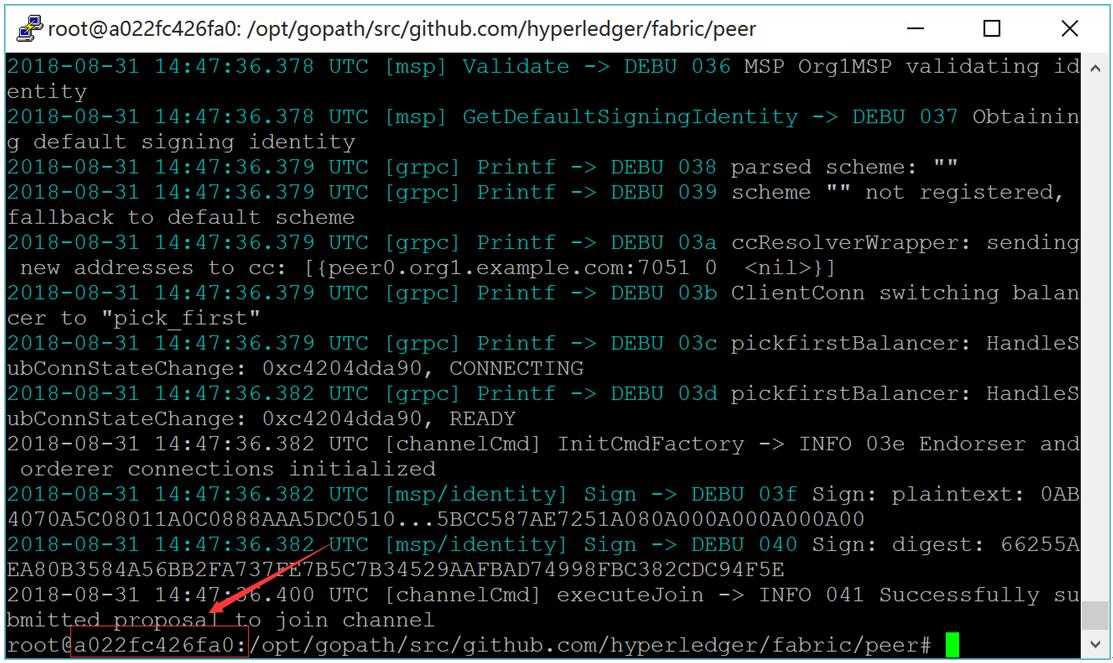
图:cli客户端
# exit
# docker cp xxxxxxxx:/opt/gopath/src/github.com/hyperledger/fabric/peer/mychannel.block /opt/gopath/src/github.com/hyperledger/fabric/kafkapeer
5) mychannel.block拷贝到其它电脑
# scp mychannel.block [email protected]192.168.235.8:/opt/gopath/src/github.com/hyperledger/fabric/kafkapeer # scp mychannel.block [email protected]192.168.235.9:/opt/gopath/src/github.com/hyperledger/fabric/kafkapeer # scp mychannel.block [email protected]192.168.235.10:/opt/gopath/src/github.com/hyperledger/fabric/kafkapeer
3. 安装与运行智能合约
1) 安装智能合约
# docker exec -it cli bash # peer chaincode install -n mycc -p github.com/hyperledger/fabric/kafkapeer/chaincode/go/example02/cmd/ -v 1.0
2) 实例化智能合约
区块初始化数据为a为200,b为400。
# ORDERER_CA=/opt/gopath/src/github.com/hyperledger/fabric/peer/crypto/ordererOrganizations/example.com/orderers/orderer0.example.com/msp/tlscacerts/tlsca.example.com-cert.pem # peer chaincode instantiate -o orderer0.example.com:7050 --tls --cafile $ORDERER_CA -C mychannel -n mycc -v 1.0 -c ‘{"Args":["init","a","200","b","400"]}‘ -P "OR (‘Org1MSP.peer‘,‘Org2MSP.peer‘)"
3) Peer上查询a,显示200
# peer chaincode query -C mychannel -n mycc -c ‘{"Args":["query","a"]}‘
查询a成功结果如下图所示:
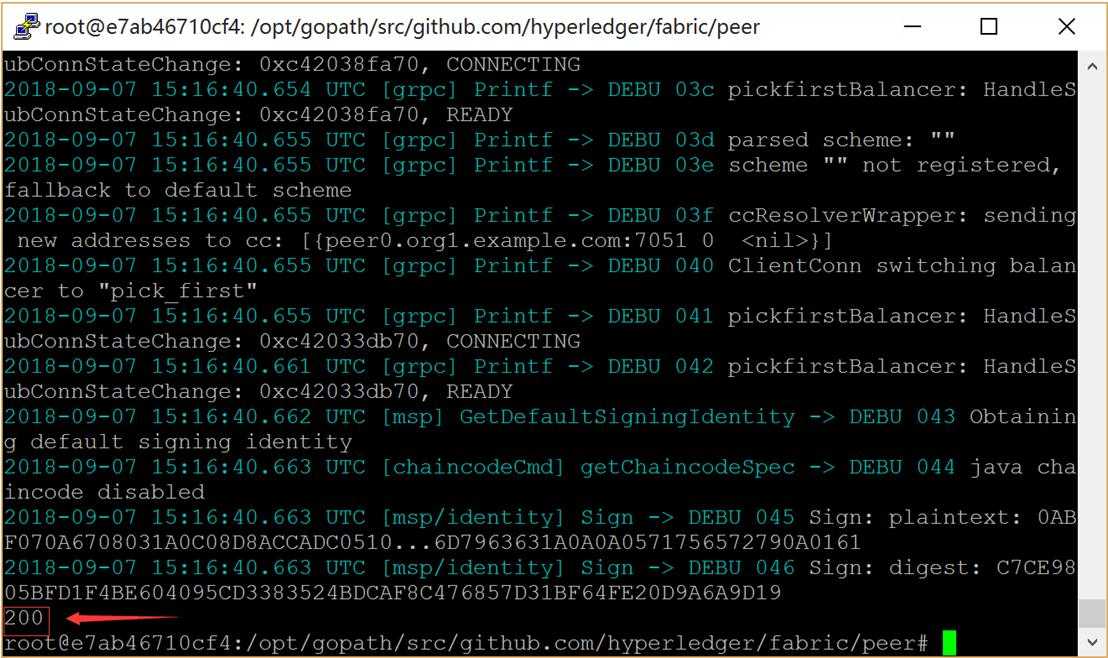
图:查询a成功结果
11.5.2 服务器(192.168.235.8)运行
1 准备部署智能合约
拷贝examples/chaincode/go/example02目录下的文件到kafkapeer/chaincode/go/example02目录下。
2 启动Fabric网络
1) 启动peer
# cd $GOPATH/src/github.com/hyperledger/fabric/kafkapeer
# docker-compose -f docker-compose-peer.yaml up -d
2) 启动cli容器
# docker exec -it cli bash
3) 拷贝mychannel.block到peer中
命令的xxxxxxxx替换为图中红框中的字符。
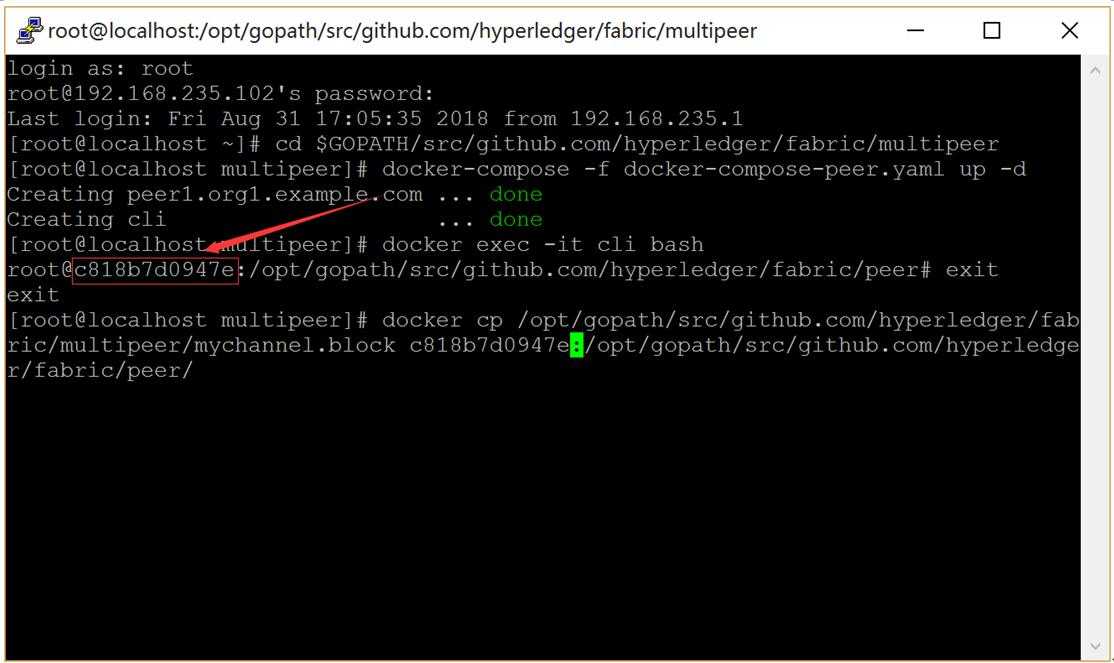
图:cli客户端
# exit
# docker cp /opt/gopath/src/github.com/hyperledger/fabric/kafkapeer/mychannel.block xxxxxxxx:/opt/gopath/src/github.com/hyperledger/fabric/peer/
4) Peer加入Channel
# docker exec -it cli bash
# peer channel join -b mychannel.block
3 安装与运行智能合约
1) 安装智能合约
# peer chaincode install -n mycc -p github.com/hyperledger/fabric/kafkapeer/chaincode/go/example02/cmd/ -v 1.0
2) Peer上进行a向b转20交易
# ORDERER_CA=/opt/gopath/src/github.com/hyperledger/fabric/peer/crypto/ordererOrganizations/example.com/orderers/orderer0.example.com/msp/tlscacerts/tlsca.example.com-cert.pem # peer chaincode invoke --tls --cafile $ORDERER_CA -C mychannel -n mycc -c ‘{"Args":["invoke","a","b","20"]}‘
交易成功结果如下图所示:
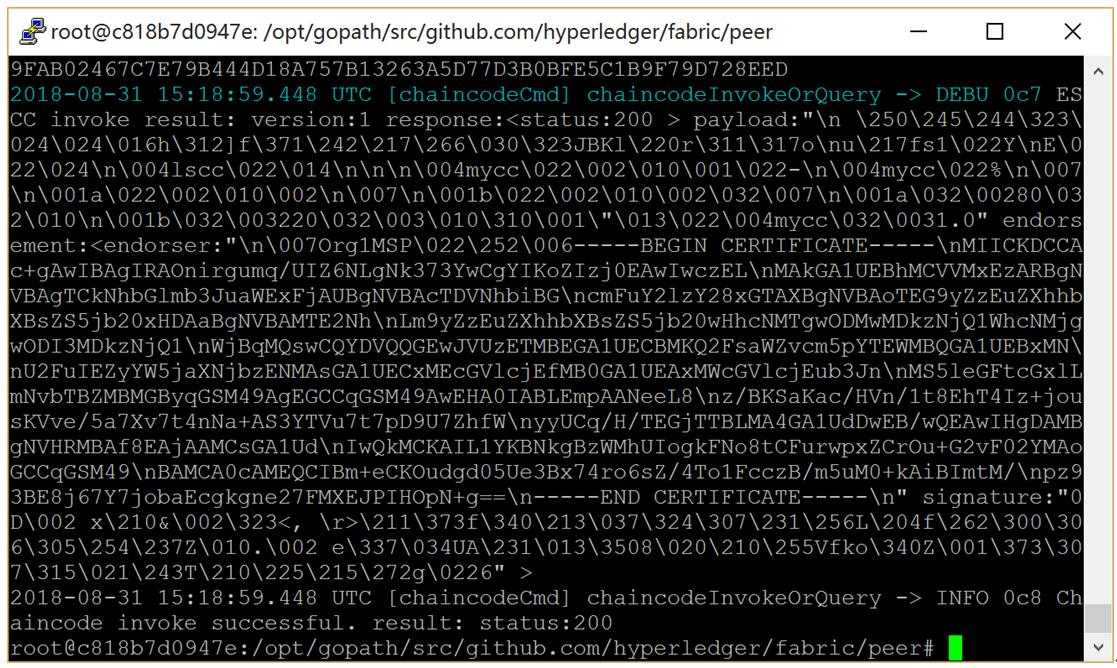
图:交易成功结果
11.5.3 服务器(192.168.235.9)运行
1 准备部署智能合约
拷贝examples/chaincode/go/example02目录下的文件到kafkapeer/chaincode/go/example02目录下。
2 启动Fabric网络
1) 启动peer
# cd $GOPATH/src/github.com/hyperledger/fabric/kafkapeer
# docker-compose -f docker-compose-peer.yaml up -d
2) 启动cli容器
# docker exec -it cli bash
3) 拷贝mychannel.block到peer中
命令的xxxxxxxx替换为图中红框中的字符。
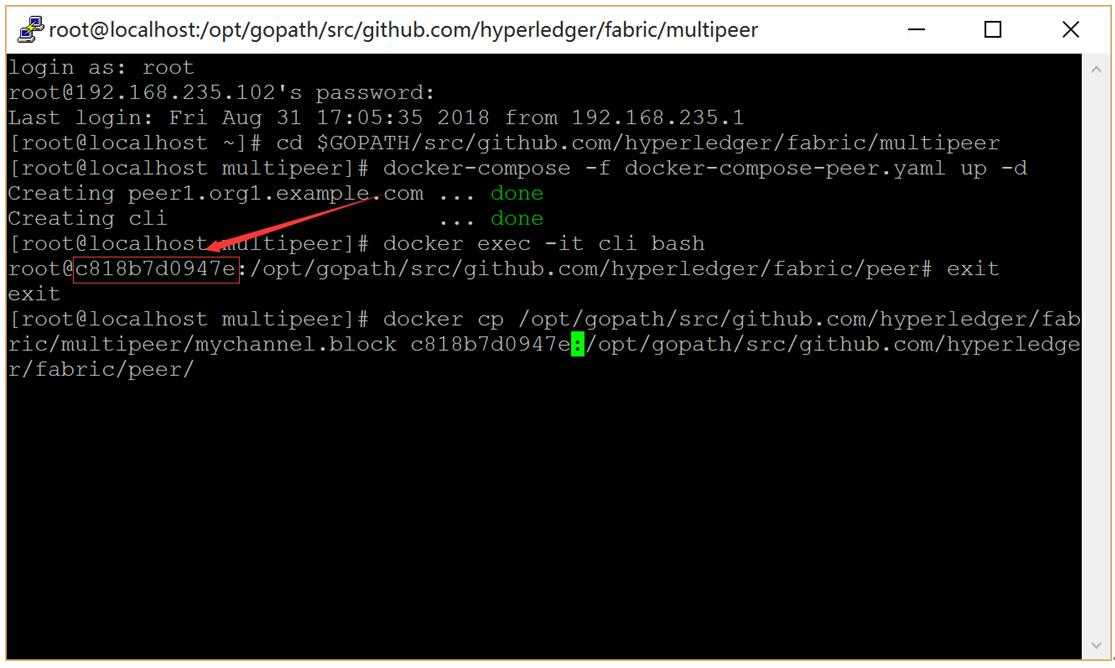
图:cli客户端
# exit
# docker cp /opt/gopath/src/github.com/hyperledger/fabric/kafkapeer/mychannel.block xxxxxxxx:/opt/gopath/src/github.com/hyperledger/fabric/peer/
4) Peer加入Channel
# docker exec -it cli bash
# peer channel join -b mychannel.block
3 安装与运行智能合约
1) 安装智能合约
# peer chaincode install -n mycc -p github.com/hyperledger/fabric/kafkapeer/chaincode/go/example02/cmd/ -v 1.0
2) Peer上查询a,显示180
# peer chaincode query -C mychannel -n mycc -c ‘{"Args":["query","a"]}‘
查询a成功结果如下图所示:

图:查询a成功结果
3) Peer上进行a向b转50交易
# ORDERER_CA=/opt/gopath/src/github.com/hyperledger/fabric/peer/crypto/ordererOrganizations/example.com/orderers/orderer0.example.com/msp/tlscacerts/tlsca.example.com-cert.pem # peer chaincode invoke --tls --cafile $ORDERER_CA -C mychannel -n mycc -c ‘{"Args":["invoke","a","b","50"]}‘
交易成功结果如下图所示:
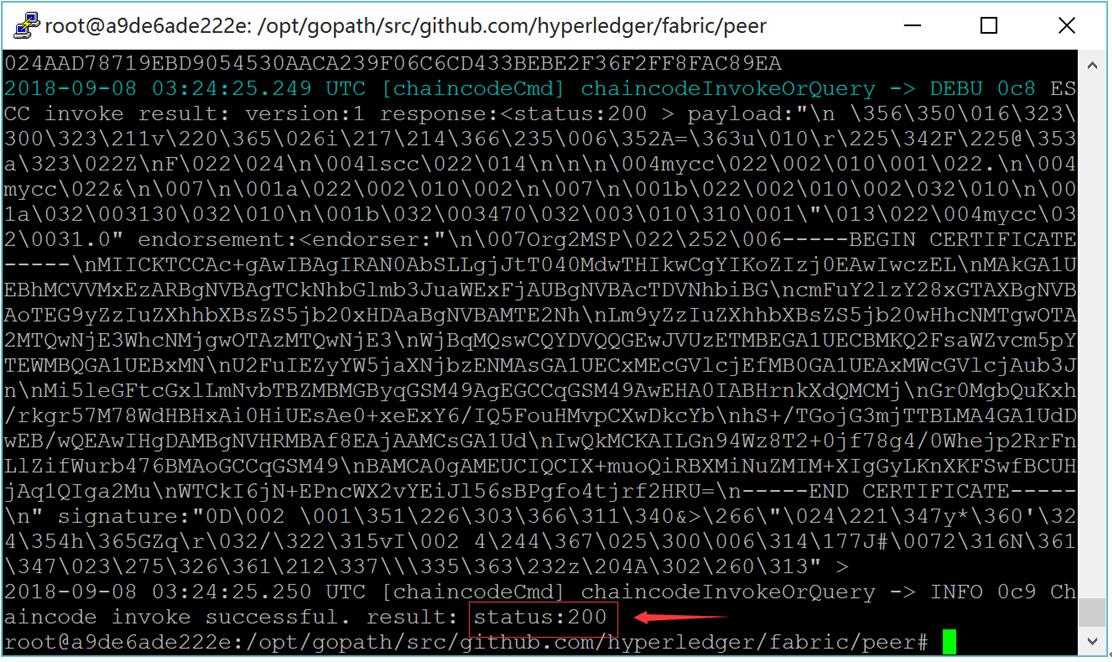
图:交易成功结果
11.5.4 服务器(192.168.235.10)运行
1 准备部署智能合约
拷贝examples/chaincode/go/example02目录下的文件到kafkapeer/chaincode/go/example02目录下。
2 启动Fabric网络
1) 启动peer
# cd $GOPATH/src/github.com/hyperledger/fabric/kafkapeer
# docker-compose -f docker-compose-peer.yaml up -d
2) 启动cli容器
# docker exec -it cli bash
3) 拷贝mychannel.block到peer中
命令的xxxxxxxx替换为图中红框中的字符。

图:cli客户端
# exit
# docker cp /opt/gopath/src/github.com/hyperledger/fabric/kafkapeer/mychannel.block xxxxxxxx:/opt/gopath/src/github.com/hyperledger/fabric/peer/
4) Peer加入Channel
# docker exec -it cli bash
# peer channel join -b mychannel.block
3 安装与运行智能合约
1) 安装智能合约
# peer chaincode install -n mycc -p github.com/hyperledger/fabric/kafkapeer/chaincode/go/example02/cmd/ -v 1.0
2) Peer上查询a,显示130
# peer chaincode query -C mychannel -n mycc -c ‘{"Args":["query","a"]}‘
查询a成功结果如下图所示:
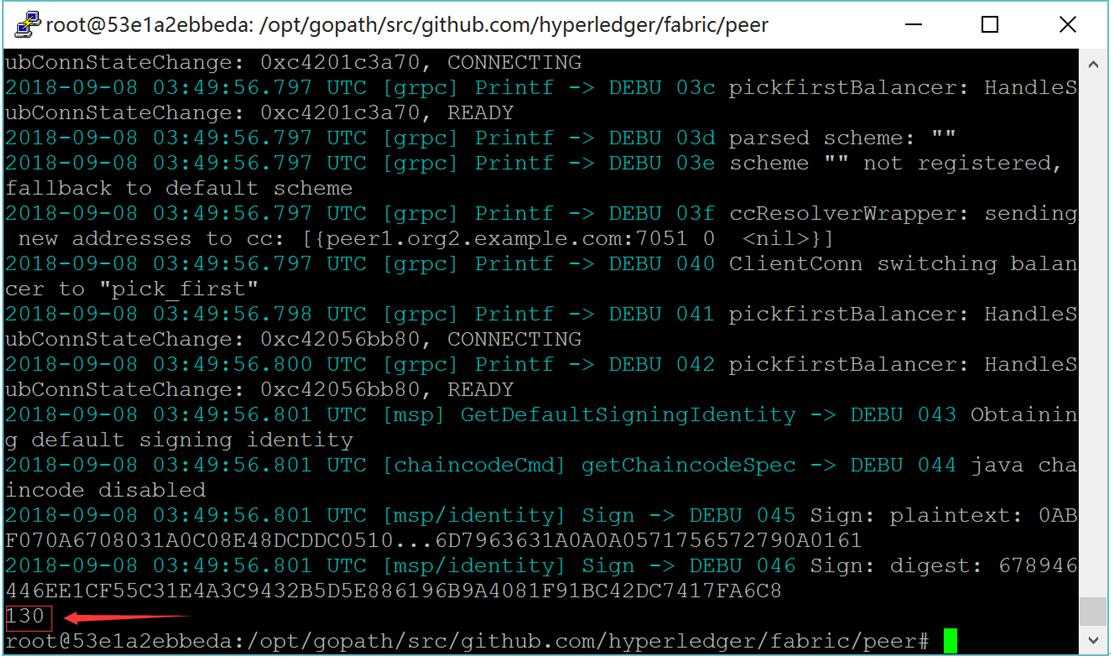
图:查询a成功结果
3) Peer上查询b,显示470
# peer chaincode query -C mychannel -n mycc -c ‘{"Args":["query","b"]}‘
查询b成功结果如下图所示:
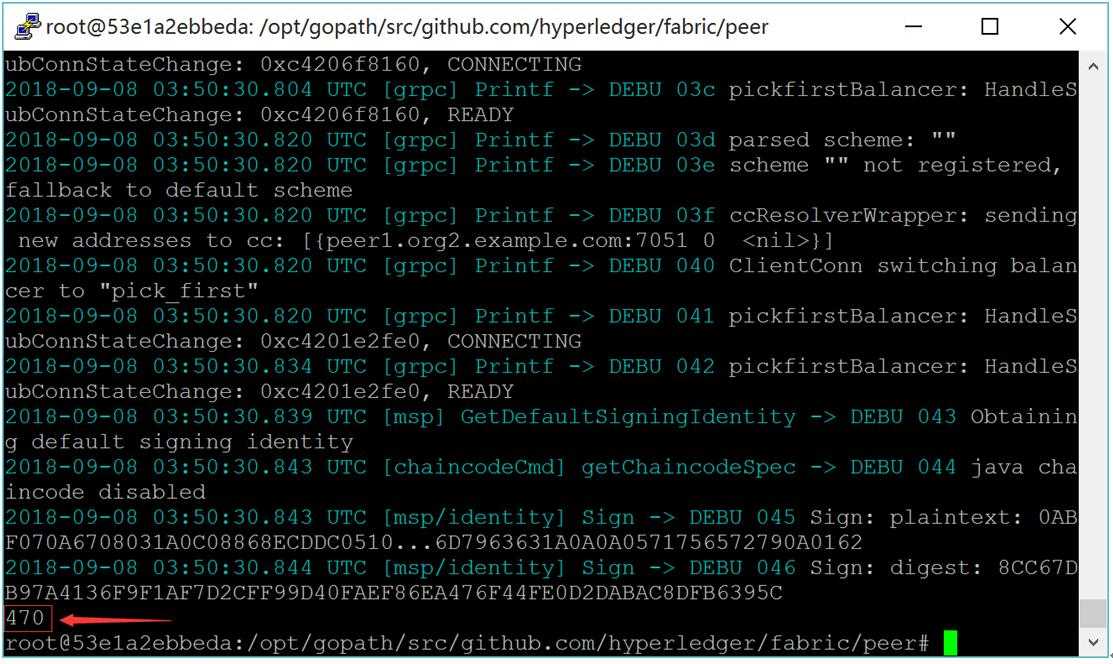
图:查询b成功结果
以上是关于kafka集群环境部署fabric1.4.6的主要内容,如果未能解决你的问题,请参考以下文章